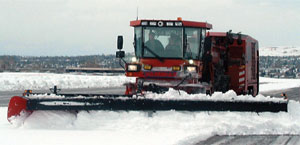
Features
Operations
No Business Like Snow Business
Even in winter-familiar Canada, there is more to snow than meets the eye.
October 1, 2007 By John Scott
 WINTER AND GROUND de-icing procedures are a constant occurrence with
WINTER AND GROUND de-icing procedures are a constant occurrence with
which the pilot, ATC ground controllers, airfield maintenance and
de-icing providers have to contend. To the pilot, rate of snowfall,
temperature and visibility are major considerations as to de-icing
fluid choice and holdover time.
Any
snowfall triggers a series of actions taken either by an airport
weather observer, or by the flight crew at airports where an observer
is not available. At a fully-staffed airport, a weather observer
routinely proceeds to a known observation point and determines
visibility in the appropriate quadrants. He then refers to the
appropriate Manual of Operations (MANOPS) and issues the readings.
(Note: visibility research has shown to often give a misleading
indication of the actual liquid equivalent rate.)
However, the
visibility readings taken by the observer have no correlation to the
current temperature. Yet, icing hazard for aircraft relates directly to
snow/water content rather than visibility. The conundrum is that
visibility as assessed by the observer through falling snow has, for
many years, been the determinant for rate. Rate is then assumed to be
water content. Water content determines de-icing fluid effectiveness/
holdover time. Liquid equivalent rate is important because it is the
dilution of the de-icing fluid which causes the fluid to fail and stop
protecting the wing against icing.
For the purpose of this
article we will set up a situation at Somespot Airport, where the time
is 16:30 local, the temperature is -8°C, it is snowing moderately and
the airport has no weather observer. The aircraft is planned to be
de-iced with SAE Type I fluid. The crew look out the cockpit window and
determine the visibility and rate of snowfall using known distances to
objects. They refer to SAE holdover charts in their Quick Reference
Handbook or appropriate company document (a copy of which can be found
at www.tc.gc.ca/CivilAviation/ commerce/HoldoverTime/tab 1e1s3gm.htm).
The
crew calculated the effective holdover time after the commencement of
spraying for this fluid would be: 04:06 minutes for moderate snowfall
(which is defined as a liquid equivalent snow rate of 1-2.5 mm/hr by
the SAE.) But darkness has onset by the time the crew is ready for
deicing, and the FO observes that there is much better visibility now.
Yet, neither the rate of snowfall nor temperature has changed. (At
night, visibility actually improves because the human eye can see a
light source better than in the day.)